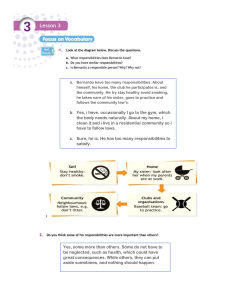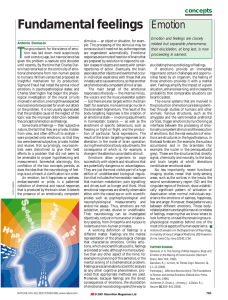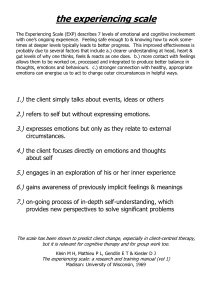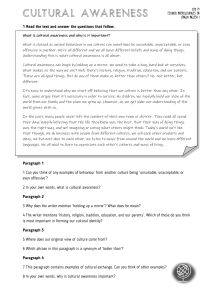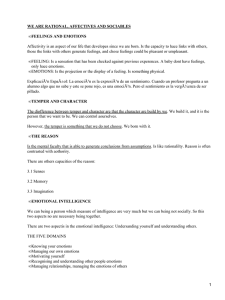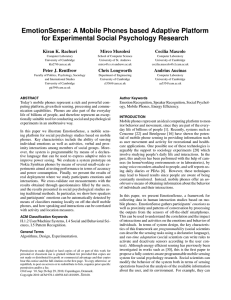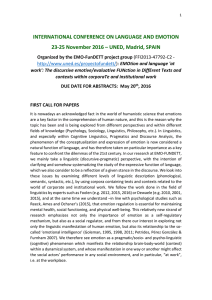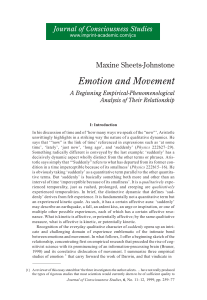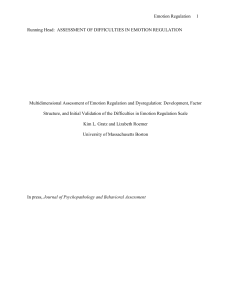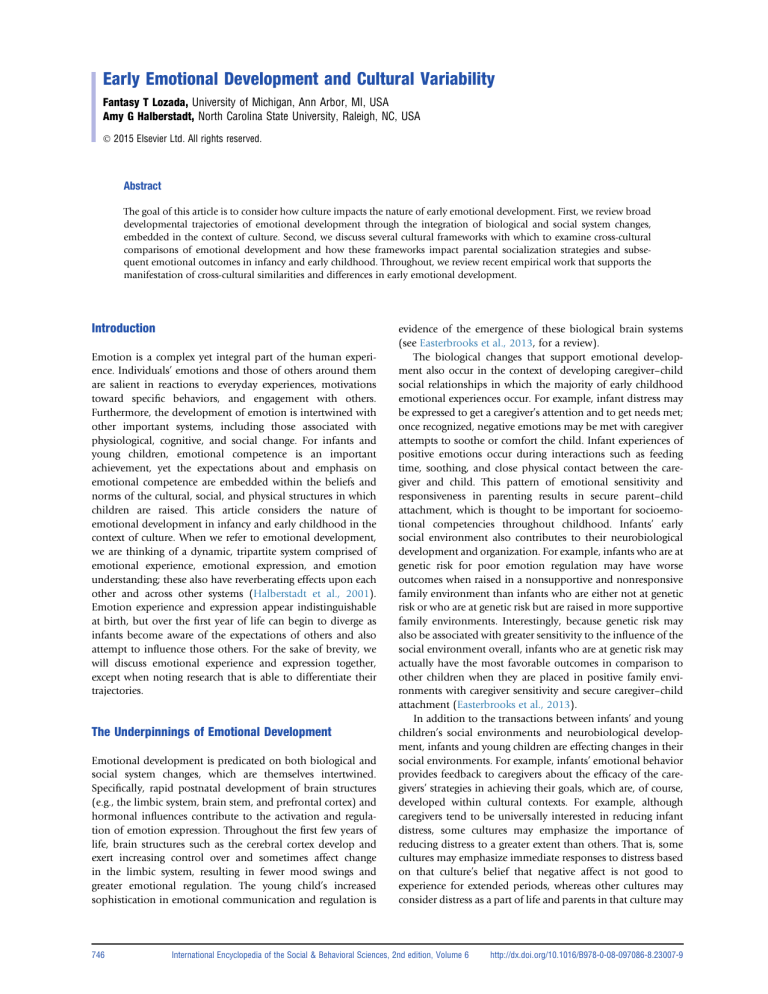
Early Emotional Development and Cultural Variability Fantasy T Lozada, University of Michigan, Ann Arbor, MI, USA Amy G Halberstadt, North Carolina State University, Raleigh, NC, USA Ó 2015 Elsevier Ltd. All rights reserved. Abstract The goal of this article is to consider how culture impacts the nature of early emotional development. First, we review broad developmental trajectories of emotional development through the integration of biological and social system changes, embedded in the context of culture. Second, we discuss several cultural frameworks with which to examine cross-cultural comparisons of emotional development and how these frameworks impact parental socialization strategies and subsequent emotional outcomes in infancy and early childhood. Throughout, we review recent empirical work that supports the manifestation of cross-cultural similarities and differences in early emotional development. Introduction Emotion is a complex yet integral part of the human experience. Individuals’ emotions and those of others around them are salient in reactions to everyday experiences, motivations toward specific behaviors, and engagement with others. Furthermore, the development of emotion is intertwined with other important systems, including those associated with physiological, cognitive, and social change. For infants and young children, emotional competence is an important achievement, yet the expectations about and emphasis on emotional competence are embedded within the beliefs and norms of the cultural, social, and physical structures in which children are raised. This article considers the nature of emotional development in infancy and early childhood in the context of culture. When we refer to emotional development, we are thinking of a dynamic, tripartite system comprised of emotional experience, emotional expression, and emotion understanding; these also have reverberating effects upon each other and across other systems (Halberstadt et al., 2001). Emotion experience and expression appear indistinguishable at birth, but over the first year of life can begin to diverge as infants become aware of the expectations of others and also attempt to influence those others. For the sake of brevity, we will discuss emotional experience and expression together, except when noting research that is able to differentiate their trajectories. The Underpinnings of Emotional Development Emotional development is predicated on both biological and social system changes, which are themselves intertwined. Specifically, rapid postnatal development of brain structures (e.g., the limbic system, brain stem, and prefrontal cortex) and hormonal influences contribute to the activation and regulation of emotion expression. Throughout the first few years of life, brain structures such as the cerebral cortex develop and exert increasing control over and sometimes affect change in the limbic system, resulting in fewer mood swings and greater emotional regulation. The young child’s increased sophistication in emotional communication and regulation is 746 evidence of the emergence of these biological brain systems (see Easterbrooks et al., 2013, for a review). The biological changes that support emotional development also occur in the context of developing caregiver–child social relationships in which the majority of early childhood emotional experiences occur. For example, infant distress may be expressed to get a caregiver’s attention and to get needs met; once recognized, negative emotions may be met with caregiver attempts to soothe or comfort the child. Infant experiences of positive emotions occur during interactions such as feeding time, soothing, and close physical contact between the caregiver and child. This pattern of emotional sensitivity and responsiveness in parenting results in secure parent–child attachment, which is thought to be important for socioemotional competencies throughout childhood. Infants’ early social environment also contributes to their neurobiological development and organization. For example, infants who are at genetic risk for poor emotion regulation may have worse outcomes when raised in a nonsupportive and nonresponsive family environment than infants who are either not at genetic risk or who are at genetic risk but are raised in more supportive family environments. Interestingly, because genetic risk may also be associated with greater sensitivity to the influence of the social environment overall, infants who are at genetic risk may actually have the most favorable outcomes in comparison to other children when they are placed in positive family environments with caregiver sensitivity and secure caregiver–child attachment (Easterbrooks et al., 2013). In addition to the transactions between infants’ and young children’s social environments and neurobiological development, infants and young children are effecting changes in their social environments. For example, infants’ emotional behavior provides feedback to caregivers about the efficacy of the caregivers’ strategies in achieving their goals, which are, of course, developed within cultural contexts. For example, although caregivers tend to be universally interested in reducing infant distress, some cultures may emphasize the importance of reducing distress to a greater extent than others. That is, some cultures may emphasize immediate responses to distress based on that culture’s belief that negative affect is not good to experience for extended periods, whereas other cultures may consider distress as a part of life and parents in that culture may International Encyclopedia of the Social & Behavioral Sciences, 2nd edition, Volume 6 http://dx.doi.org/10.1016/B978-0-08-097086-8.23007-9 Early Emotional Development and Cultural Variability respond less quickly so that children can practice self-soothing or regulation. Within these contexts, caregivers learn from infants’ emotionality regarding the success of their strategies in reducing current distress and/or avoiding similar instances in the future. In this way, the infant and the culture work together to scaffold caregiving responses. Emotional Development Trajectories Emotional Experience and Expression Research on the development of emotional experience focuses on two types of broad emotional categories: primary or basic emotions (e.g., happiness, sadness, anger, fear, disgust, and surprise) which appear in both humans and some animals and self-conscious or self-in-relation emotions (e.g., jealousy, embarrassment, pride, shame, guilt, and empathy) and those which require advanced cognition about the self in relation to others. Although basic emotions are assumed to be universal, only broad emotional reactions are thought to be present at birth. Instead, maturational shifts in biological brain functioning and increases in attention and subsequent organizational and interpretive skill in assessing the environment facilitate the emergence of the basic emotions throughout the first year of life. Although researchers have thought previously that emotions rely entirely on maturational aspects, given that elements of joy, sadness, anger, and disgust are reported to appear around 3 months, recent reviews suggest that prototypical expressions of these emotions develop slowly over the first year of life (Camras and Shutter, 2010; Halberstadt et al., 2013). Because infants are also beginning during this time to understand the norms of their social world, their expression of even basic emotions may reflect the norms of their culture. This question remains largely untested with infants and children, with geographic ‘dialects’ in emotion expression only recently identified in adults (Elfenbein, 2013). The more cognitively complex emotions that consider the self in relation to others, such as jealousy, embarrassment, shame, pride, and guilt, emerge later in the second year of life, and may be even more subject to cultural influence. Infants begin the lifelong task of developing the skills of regulating emotions in terms of inhibiting and/or minimizing the intensity and duration of their emotional experiences. Although caregivers are important emotion regulators throughout infancy and childhood, infants also engage in a variety of self-soothing behaviors from an early age, including thumb sucking, gaze aversion, and distraction. Furthermore, as young children develop in their self-awareness and ability to use language to describe feeling states, they are also able to verbalize contexts that make them feel distressed or give them joy (Kopp and Neufeld, 2002). Emotion Understanding Infants’ basic abilities in distinguishing between positive and negative emotions occur within the first few months of life. We do not know yet whether distinguishing between these emotions is accompanied by an understanding of the feeling state of the other person, although social referencing studies, in which 12–14 month olds pause in response to caregivers’ fear 747 responses, indicate infants’ use of emotional information to inform how they should react to novel situations and potential danger, in particular. Although infants may begin to use social referencing as early as 6 months of age, they become increasingly skilled at checking in with caregivers before acting to see if their faces reflect fear, happiness, or anger. Young children may also utilize social referencing when interested in feedback, such as when looking for validation from a caregiver after completing a difficult task or checking for anger when reaching for a forbidden object. Although some 2 year olds are able to identify and also generate facial expressions reflecting basic emotions upon demand, these skills become increasingly developed over time. Related Domains Related research domains that inform our understanding of emotional development in infancy and early childhood are those of temperament and attachment. Temperament literature describes infants’ behavioral styles in terms of their general emotional responses to a variety of situations. Researchers have proposed several ways of classifying infants’ temperament, and these include components of positive and negative affectivity, self- or emotion regulation, and activity level. Many infants’ overall behavior is characterized by a general display of positive affect and ability and a propensity to adapt easily to novel situations, including emotional adaptability. However, other infants’ overall demeanor may reflect general negative affect, and they may show little ability to attenuate negative emotion expressions, even after no longer being in the presence of the cause of distress. Temperament classifications tend to demonstrate stability throughout childhood, even when children’s environmental niches shift. Temperament is likely genetically inherited, however, increasing evidence supports the substantial role of environmental experience in modifying outcomes (Henderson and Wachs, 2007). Attachment describes the emotional bond between the infant and the caregiver. Theories of attachment often note the importance of the caregiver’s responsiveness to the infant’s emotional expression as a pathway by which a deep, trusting emotional bond is created. Infant–caregiver attachments develop from infants’ instinctive preference toward other humans at birth to attachment formation with primary caregivers as infants distinguish between familiar others and strangers (Van Ijzendoorn and Sagi-Schwartz, 2008). The discussion of attachment is relevant because it reflects how emotional development occurs in the context of social relationships and the importance of emotional bonds for the developing child. Although it may be tempting to accept the developmental trends of emotion competence previously described as universal, culture may impact the emergence of emotion and emotion-related components. Many of the laboratory and naturalistic observation paradigms used to measure and explore infants’ emotional functioning were developed to examine emotional competence based on Western theory with Western samples. However, when similar yet culturally appropriate paradigms have been used to explore infants’ emotional functioning, some universal assumptions have been challenged. For example, when a culturally appropriate version 748 Early Emotional Development and Cultural Variability of the commonly used strange situation paradigm was used with Nso 1 year olds, the ‘universal’ representation of secure attachment as characterized by stranger-evoked distress and caregiver-evoked comfort was not present. In contrast, a large number of Nso infants showed no emotional reaction to the stranger (Keller and Otto, 2009). These results suggest that we need to re-think both the operationalization and measurement of attachment in terms of cultural norms and expectations. We further discuss the consideration of culture in emotional development in infancy and how parental socialization inculcates cultural expectations for infants’ emotional functioning. Culture Culture, as we define it, is the shared pattern of beliefs, values, behaviors, and language learned through inter- and intragenerational socialization. Culture determines the physical and social environments of infant development (Super and Harkness, 1986). To understand how culture impacts emotional development, researchers have targeted emotion socialization as the mediating pathway between cultural context and children’s emotional competence and functioning. Parent–child relations are infused with culture through practices that dictate the way that parents and children interact with each other and the cultural belief systems that impact the interpretation of those interactions. Infants also learn about culture through experience-expectant (speciestypical neural preparedness to integrate information from the environment) and experience-dependent (individual neural changes due to learning and experience) processes (Keller, 2007). Throughout infancy, children develop emotional competence by increasingly integrating information from parent–child interactions across cognitive, physiological, and motoric domains. We briefly review the cross-cultural literature on parental emotion socialization before discussing the nature of culture-specific features and cultural commonalities of emotion development in early childhood. Emotion Socialization: A Cultural Pathway to Emotional Development Parental emotion socialization is thought to be one of the most important influences on infants’ and children’s emotional development; caregivers’ own emotional experience, communication, sensitive responsiveness, and understanding of their infants’ needs help to shape the emotional world of early childhood. Parental socialization is also one of the primary ways in which culture is imparted in that caregivers’ emotional socialization behaviors are themselves shaped/governed by the expectations, beliefs, and shared knowledge of the cultures in which they live. Cross-cultural studies have noted a variety of cultural differences in parent beliefs and expectations about children’s emotions, early caregiver–child interactions, and parent emotion socialization, all of which have implications for early childhood emotion development. Several cultural frameworks have been identified to organize cultural effects on parenting practices and beliefs. These include independence–interdependence, power distance, children’s place in family and culture, ways children learn, and value of emotional experience and expression (Halberstadt and Lozada, 2011). The most common of these cultural frameworks is that of independence–interdependence, which is also often referred to as individualism–collectivism. Western cultures (i.e., United States, Germany, Greece) are most often associated with being independent or individualist. These societies consider children as separate entities from the caregiver and encourage the development of autonomy. Individualistic emotional competence encompasses self-awareness, and emotional expression and regulation of socially disengaged emotions (e.g., happiness, anger, and frustration) as assertions of individuality and autonomy. Eastern cultures (i.e., Japan, China, India) are most often described as interdependent or collectivist. Interdependent societies consider children as part of their social groups (e.g., family) rather than as individuals and encourage emotional bonding and unity between the caregiver and the child. These societies also encourage interconnectedness and group harmony. Interdependent emotional competence encourages an understanding of emotion in relation to what others are feeling, and socially engaged emotions (e.g., empathy, shame, guilt). A central goal in regulating emotional expression is to keep family and group harmony intact (Friedlmeier et al., 2011). Although researchers agree that one culture may tend toward a more individualist or collectivist orientation, it is also understood that these two orientations can exist simultaneously within cultures, with orientations existing along continuums rather than a dichotomy of polar opposites. Parenting practices that promote infants’ and children’s emotional competence, as defined by the various frameworks supported in the culture, are reflected in differences in maternal–infant body contact, feeding patterns, responses to infant vocalizations (both distress and nondistress related), sleeping patterns, and even in other aspects of the childrearing environment such as the presence of toys or the number of caregivers and family members that the infant comes in contact with on a daily basis. For example, the presence of many toys in the infants’ environment is characteristic of independent cultures and can be used to elicit positive emotion in infants or to distract from and regulate negative emotion expression. However, infants in interdependent cultures may not have as much need or opportunity to play with toys when family members or others serve as the primary elicitors and regulators of emotion. These cultural differences may affect the frequency of emotional experience or expression, and skill in understanding the emotions of self and others, but they also do much to transform the action possibilities in the environment (called affordances in the perceptual theory developed by James and Eleanor Gibson), in which the entire emotional landscape of infants and children are embedded. To continue this example: action possibilities afforded by toys are very different from those afforded by people. Materialism may also serve as an independent influence on children’s emotional development; as some interdependent cultures become more consumer-oriented, or as some families within interdependent cultures shift to a greater toy-focused parenting strategy, children’s orientation of emotional satisfaction derived from interpersonal relationships may shift to that of object engagement. Early Emotional Development and Cultural Variability Empirical studies have observed many differences in parental socialization across independence–interdependence orientations, as well as the other frameworks noted earlier. In a series of studies that compare maternal expectations of infants and mother–child interactions between urban middle class German mothers (an independent cultural context that also includes a framework which values children’s emotional experience and expression) and rural farming Cameroonian Nso mothers (an interdependent context that also includes a framework which values children’s low emotional expressivity), German mothers expected to see emotional expression early in infancy and reported having low expectations of children’s emotional control when 3 years old. Behaviorally, they engaged in more face-to-face contact, positive vocalizations, smiling, and contingent responding in early infancy. In contrast, Nso mothers had higher expectations for emotional control, even in infancy. Behaviorally, they engaged in less faceto-face contact and smiling so as to avoid arousing infant emotion. All of these reflect Nso expectations that good children are calm with little emotional expressiveness, except in the case of socially engaged emotions such as shame and guilt (Keller and Otto, 2009). As such, the German and Nso cultures varied not only on the independent–interdependent orientation, but also in their beliefs about the value of emotional experience and expression, and about how and when children learn about and control their emotions. Perhaps the most striking evidence for the early impact of cultural beliefs and norms on infants’ emotional development is the shift in smiling during mutual gaze between 6 and 12 weeks of age by the Nso and German infants; this age was studied so as to capture any developments in emotional development at what is thought to be the 2-month shift in infants’ systemic reorganization. Consistent with their beliefs and values regarding emotion expression, German mothers smiled at their infants more so than Nso mothers; although infant behavior is not different cross-culturally at 6 weeks, it is markedly different by 12 weeks, at which point German infants have substantially increased their smiling duration and imitation of mothers’ smiles, more closely matching their mothers’ behavior. Nso infants’ smiling stayed fairly stable at its lower level, again reflecting the values of Nso society for less expressiveness (Wörmann et al., 2012). It is likely that cultural norms and nuances impact infants’ and children’s organization and re-organization of their understanding of the social world around them, and their responses to that world. As noted above, although the framework of independence– interdependence is a powerful tool to use in understanding cross-cultural differences, other frameworks are needed to fully understand the richness of cross-cultural differences, as many cultural differences in emotion socialization have been noted in societies that both reflect interdependent cultural contexts. For example, the rural villages of the Tamang and ChhetriBrahmin people in Nepal are similar on many characteristics of subsistence living and belief systems of social conformity and group harmony. However, the Tamang practice Tibetan Buddhism and beliefs of egalitarianism, tolerance, and the value of mild, socially engaged emotions. The Chhetri-Brahmin are high caste Hindus whose hierarchical place in society reflect spiritual purity and who value self-control. Their high-society status, even in rural villages, promotes feelings of pride and 749 social dominance. The different belief systems due to religious affiliations represent the cultural framework of the value of emotional experience and expression and is manifest in differing patterns of socialization; Chhetri-Brahmin mothers responded more positively to their young children’s anger yet ignore children’s expressions of shame. However, Tamang mothers responded with rebuking their children’s anger (Cole et al., 2006). Although cross-cultural emotion socialization studies yield examples of many differences in parenting practices impacted by cultural beliefs and orientations, we also note evidence of universal trends in emotion socialization across cultures. For example, although maternal sensitivity may vary in its behavioral manifestations (e.g., visual or vocal contingency versus proximal contingency, frequency versus intensity of smiling in face-to-face interactions), its positive influence on infant emotional functioning is apparent across cultures. Similarly, differential responding to powerful (e.g., anger) and powerless (e.g., sadness) emotions may serve varying functions for the development of autonomy and relatedness, and also for one’s place in terms of the power distance framework, yet socialization practices that dismiss or punish children’s emotions are related to later internalizing and externalizing in later childhood in several cultures (Friedlmeier et al., 2011). The desire for culturally appropriate emotional competence in infancy is evident across cultures, but can cultural differences in emotion experience, expression, and understanding be observed in infancy and early childhood? Several findings from cross-cultural infant and preschool research are reviewed and discussed in the context of cultural orientations. Cross-Cultural Findings of Emotional Competence in Infant and Early Childhood Emotion Experience and Expression Infant emotion and experience appear indistinguishable at birth, yet as young children develop in their ability to understand the self and others’ expectations, the two abilities become differentiated. Cross-cultural differences in these abilities likely reflect cultural variations in beliefs about the value of emotional experience and expression and beliefs in the way children learn about emotions. For instance, comparisons of European American, Chinese, and Japanese infants suggest that Chinese infants are less expressive overall than both European American and Japanese infants; however, there were no significant differences in the frequency of genuine smiles and in the latency and frequency of crying (Camras et al., 1998). Differences between European American and Chinese infant emotion expression is expected because of cultural differences in the value of emotion, however, differences in Chinese and Japanese infant expression is surprising given that the cultures appear to be similar not only in collectivist orientation but also in having to place high value on the restraint of emotion expression. Although some young children of different cultural contexts exhibit different emotional reactions to comparable experiences, others show differences in the maintenance or regulation of that emotion over time. For instance, Japanese and German preschool girls were exposed to self- and other-focused distress 750 Early Emotional Development and Cultural Variability conditions to examine whether they would display culturespecific emotional reactions to their own experiences of frustration or the frustration of a playmate. Children in both groups displayed similar spontaneous distress reactions to both conditions, but the trajectories of their reactions varied by self-focused distress and other-focused distress conditions. Specifically, German girls sustained their distress throughout the duration of the self-focused distress condition but decreased their expressions in the other-focused condition. Japanese girls showed distress maintenance in the otherfocused distress condition but decreased affect in the selffocused distress condition. These findings demonstrate that although young children may display similar emotional reactions and emotion regulation patterns, culture-specific display rules may dictate the context in which these emotional experiences occur (Trommsdorff and Friedlmeier, 2010). Culturespecific display rules may also be evident in young children’s emotion-regulation behaviors. For instance, although both Japanese and German preschool girls engaged in supportseeking behaviors when distressed, Japanese girls did so by seeking closer proximity to their mothers whereas German girls engaged in social referencing their mothers by eye contact (Friedlmeier and Trommsdorff, 1999). Differences in the focus of group harmony versus autonomy in Japanese and German culture contribute to differences in the social context of these children’s reactions and the methods by which they seek to regulate emotion. Although the above, and many other studies of emotion development, identify experiential and expressive differences across cultures, other studies highlight universal aspects of emotion expression development. Studies that compare the muscular configuration of emotion expression find that infants across culture show similar expressions for happiness, sadness, and anger. Although the differences in the support for and participation in the social smile of German and Nso infants change dramatically in the first 12 weeks of life, as discussed earlier, it must be noted that the intensity of smiling between mothers and infants did not differ across the two groups (Wörmann et al., 2012). When taken together with the previous work on Japanese and German preschoolers, this work suggests that culture may have more of an impact on the context, frequency, duration, and meaning of emotional experiences, but perhaps not on the basic expression of the emotion (e.g., intensity and muscular configuration). Emotion Understanding Children’s emotion recognition abilities are considered valuable across cultures but perhaps for different reasons. For example, in interdependent cultures that promote the expression of socially engaged emotions, a child must be able to know what the other person is feeling in order to show sympathy. In independent cultures, a child may need to know what another person is feeling in order to respond in a way that would allow for the other person to have privacy as they worked to regulate their emotional experience. Although few cross-cultural studies have examined emotion recognition in early childhood, there is evidence to suggest early cross-cultural differences in emotion recognition. For instance, Chinese 4 year olds were significantly more accurate at emotion recognition than Australian 4 year olds (Markham and Wang, 1996). This is somewhat surprising given that the expectation is that children in independent cultures (e.g., Australia) would have more opportunities to learn about emotion expression because emotion expression is valued. However, it may be that children in an interdependent culture like China may gain more experience with being able to read affective information from microexpressions of emotion, making them more sensitive to the facial cues in the emotion recognition task. Similar to the dearth of cross-cultural research on emotion recognition in early childhood, very few studies have examined emotion understanding in infancy and early childhood. However, some insight into early emotion knowledge can be gleaned from studies in which children report their feelings in response to hypothetical scenarios, and these studies suggest culture-specific patterns. In response to vignettes about emotion-eliciting situations, Nepali Tamang and ChhetriBrahmin children as young as 6 years old reported emotions consistent with the display rules of their culture. Specifically, Tamang children were more likely to report that they would feel ‘just okay’ than Chhetri-Brahmin children who were more likely to report feeling anger to potentially anger-eliciting situations. This pattern reflects the Tamang adherence to Buddhist principles of avoiding strong emotionality. Although the Chhetri-Brahmin children were more likely to report that they would feel anger than Tamang children in response to the same vignettes, they were also more likely to report masking in those situations, consistent with their Hindu-oriented beliefs to engage in self-control (Cole and Tamang, 1998). The cultural differences among these two peoples support the importance of knowing a culture’s framework with regard to the value of emotion experience and expression. Future Directions Cross-cultural research on emotion in infancy and childhood has yielded a great deal of knowledge on both the cultural commonalities and differences in the development of children’s emotion experience, expression, and understanding. However, our knowledge of how these developmental trajectories vary is still limited to relatively few cultures which mainly vary on independent–interdependent conceptions of the self. Empirical studies that examine emotional competence across cultures that vary in their views of structural hierarchy, views on children’s societal roles and competence, and beliefs about emotion may yield a more nuanced view in how cultural belief systems impact parental emotion socialization and changes in emotional competence in early childhood (Halberstadt and Lozada, 2011). Above all, advancements in culturally appropriate theories and methods are needed to make more consistent observations of the precursors of emotional development in a variety of cultures. Such advancements would allow emotion researchers to answer many of the basic questions about the nature of emotion that are still debated today. See also: Cross-Cultural Research Methods in Psychology; Culture and Emotion; Emotion and Expression; Emotion, Early Emotional Development and Cultural Variability Perception and Expression of; Emotional Development, Effects of Parenting and Family Structure On; Neonatal Temperament: From Phenomenology to Mechanism; Parenting Attitudes and Beliefs across Cultures; Self-Regulation During Early Childhood Across Cultures, Development of; Social and Emotional Development in the Context of the Family. Bibliography Camras, L.A., Shutter, J.M., 2010. Emotional facial expressions in infancy. Emotion Review 2, 120–129. http://dx.doi.org/10.1177/1754073909352529. Camras, L.A., Oster, H., Campos, J., Campos, R., Ujiie, T., Miyake, K., Wang, L., Meng, Z., 1998. Production of emotional facial expressions in European American, Japanese, and Chinese infants. Developmental Psychology 34, 616–628. Retrieved from 10.1037/0012-1649.34.4.616. Cole, P.M., Tamang, B.L., 1998. Nepali children’s ideas about emotional displays in hypothetical challenges. Developmental Psychology 34, 640–646. http:// dx.doi.org/10.1037/0012-1649.34.4.640. Cole, P.M., Tamang, B.L., Shrestha, S., 2006. Cultural variations in the socialization of young children’s anger and shame. Child Development 77, 1237–1251. http:// dx.doi.org/10.1111/j.1467-8624.2006.00931.x. Easterbrooks, M.A., Bartlett, J.D., Beeghly, M., Thompson, R.A., 2013. Social and emotional development in infancy. In: Lerner, R.M., Easterbrooks, M.A., Mistry, J., Weiner, I.B. (Eds.), Handbook of Psychology, Vol. 6: Developmental Psychology, second ed., vol. 6. John Wiley & Sons, Inc., Hoboken, New Jersey, pp. 91–120. Elfenbein, H.A., 2013. Nonverbal dialects and accents in facial expressions of emotion. Emotion Review 5, 90–96. Retrieved from 10.1177/1754073912451332. Friedlmeier, W., Trommsdorff, G., 1999. Emotion regulation in early childhood: a cross-cultural comparison between German and Japanese toddlers. Journal of Cross-Cultural Psychology 30, 684–711. http://dx.doi.org/10.1177/ 0022022199030006002. Friedlmeier, W., Corapci, F., Cole, P.M., 2011. Emotion socialization in cross-cultural perspective. Social and Personality Psychology Compass 5, 410–427. 751 Halberstadt, A.G., Lozada, F.T., 2011. Emotion development in infancy through the lens of culture. Emotion Review 3, 158–168. http://dx.doi.org/10.1177/ 1754073910387946. Halberstadt, A.G., Denham, S.A., Dunsmore, J.C., 2001. Affective social competence. Social Development 10, 79–119. http://dx.doi.org/10.1111/1467-9507.00150. Halberstadt, A.G., Parker, A.E., Castro, V.L., 2013. Nonverbal communication: developmental perspectives. In: Hall, J.A., Knapp, M.L. (Eds.), Handbook of Communication Science, Nonverbal Communication, vol. 2. de Gruyter Mouton, Berlin, pp. 93–127. Henderson, H.A., Wachs, T.D., 2007. Temperament theory and the study of cognitionemotion interactions across development. Developmental Review 27, 396–427. http://dx.doi.org/10.1016/j.dr.2007.06.004. Keller, H., 2007. Cultures of Infancy. Lawrence Erlbaum Associates Publishers, Mahwah. Keller, H., Otto, H., 2009. The cultural socialization of emotion regulation during infancy. Journal of Cross-Cultural Psychology 40, 996–1011. http://dx.doi.org/ 10.1177/0022022109348576. Kopp, C.B., Neufeld, S.J., 2002. Emotional development in infancy. In: Davidson, R. (Ed.), Handbook of Affective Sciences. Oxford University Press, New York. Markham, R., Wang, L., 1996. Recognition of emotion by Chinese and Australian children. Journal of Cross-Cultural Psychology 27, 616–643. http://dx.doi.org/ 10.1177/0022022196275008. Super, C.M., Harkness, S., 1986. The developmental niche: a conceptualization at the interface of child and culture. International Journal of Behavioral Development 9, 545–569. Trommsdorff, G., Friedlmeier, W., 2010. Preschool girls’ distress and mothers’ sensitivity in Japan and Germany. European Journal of Developmental Psychology 7, 350–370. http://dx.doi.org/10.1080/17405620802252742. Van Ijzendoorn, M.H., Sagi-Schwartz, A., 2008. Cross cultural patterns of attachment: universal and contextual dimensions. In: Cassidy, J., Shaver, P.R. (Eds.), Handbook of Attachment: Theory, Research, and Clinical Applications, second ed. Guilford Press, New York, pp. 880–905. Wörmann, V., Holodynski, M., Kärtner, J., Keller, H., 2012. A cross-cultural comparison of the development of the social smile: a longitudinal study of maternal and infant imitation in 6- and 12-week-old infants. Infant Behavior & Development 35, 335–347. http://dx.doi.org/10.1016/j.infbeh.2012.03.002.
